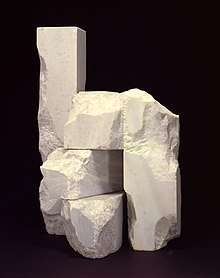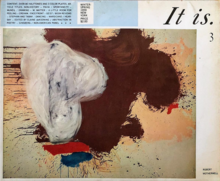Philip Pavia
Philip Pavia (1911-2005), the pioneering first-generation son of an Italian stone carver, "turned rocks into art."[1][2] The Times of London called Pavia "arguably more of an original than some of his better-known contemporaries."[3] He was rare among his peers for sculpting abstract and figurative art, and he took full advantage of a lengthy 74-year career to develop his reach. Although he started his career as a draftsman and watercolorist, Pavia ultimately made his mark with a body of work that spanned all-abstract bronzes, black-and-white abstractions in Carrara marble and, just prior to his death in 2005, at aged 94, a dozen monumental terracotta heads.[4]
Philip Pavia | |
|---|---|
 "Amazon on Horseback," 1965, marble, Smithsonian American Art Museum, Gift of Mr. and Mrs. David K. Anderson, Martha Jackson Memorial Collection, 1980.137.86 | |
| Born | March 16, 1911 |
| Died | April 13, 2005 (aged 94) New York, New York |
| Nationality | American |
| Education | Yale, Art Students League, Accademia delle Belle Arti |
| Occupation | Sculptor. Founder-Editor of It is. A Magazine for Abstract Art |
| Style | Abstract Expressionism |
| Spouse(s) | Natalie Edgar |
| Children | Luigi (b. 1968; d. 2012), Paul (b. 1971) |
| Website | http://philippavia.com/chronology.html |
Best known for his large-scale assemblages and scatter sculpture, Pavia's work has been installed on the grounds of several major public sites. He was one of four chosen to help sculpt 10 pieces for New York City's first Sculpture Symposium at the Cooper Hewitt Museum of Design in 1971.[5] His independent installations included the 10-foot-high marble abstraction Wind, Sand and Stars, installed at New York's Cloisters Museum, and the Ides of March, which stood on Sixth Avenue, outside of the New York Hilton, for nearly 25 years.[4]
Called an "outspoken avant-garde thinker"[6] by the Boston Globe, Pavia decided to organize regular gatherings of artists, writers and thinkers to socialize and discuss modern art in 1948.[3] The result, inspired by the salons of Paris and post-war desire for art that wasn't borrowed from Europe, was the 8th Street Club, known as "the Club," and its 1959-1970 successor group, known as the "23rd Street Workshop Club."[7][8] Many of New York's most important mid-century artists and thinkers were Club-goers, including Willem de Kooning, Franz Kline, Isamu Noguchi and Robert Motherwell. Together, they helped lend New York's art scene the vitality and international influence Paris had long monopolized, and U.S. artists had long craved.[9][3][8] In 1958, Pavia extended the Club's work into a journal, with the short-lived but influential It is. A Magazine for Abstract Art.[9]
Education
After two years at Yale studying architecture, Pavia transferred to the Art Students League of New York in 1931,[10] which is where he met life-long friend, fellow abstract expressionist Jackson Pollock. He alternated his New York studies, with travel and studies in Europe, where he met Henry Miller.[11] He settled in New York City permanently in 1937, and along with "Bill de Kooning, Landes Lewitin, Franz Kline, Jack Tworkov, and a few others,"[9] worked as a Federal Art Project artist, an experience he described as an important training ground both for the group that pioneered abstract expressionism:
Imagine thousands of artists in all forty-eight states getting paid to work as artists. They really learned how to paint during the program even though everyone was doing all kinds of things; making caricatures, cartoons, illustrations—it didn’t matter. That was the point: they were practicing, training themselves, so that when Abstract Expressionism came around they were ready. If it weren’t for the WPA we wouldn’t have had artists coming together like that. When the war was over in 1945, all of a sudden it was a different story.[9]
The Club
In 1948, Pavia helped found the Club, envisioning regular debate about issues in art during twice-weekly lectures, members-only panel conversations and other events.[9][12] Established shortly after the war, the Club was, in part, a response to American artists intimidated by the modernists who had taken refuge in New York after the war.
"[T]here were geniuses walking in the streets, you know. About 30 of them," Pavia told the New York Times in 2002. "They included Piet Mondrian, Max Ernst, Josef Albers, Marcel Breuer, Yves Tanguy, André Breton and Marcel Duchamp. Matisse came for a visit and everybody lined up to see him.... Eventually, [Pavia] says, the refugees moved uptown, and the Americans decided to take them on."[8] First Pollock rejected surrealism and Jungian imagery, then de Kooning followed suit. After a series of Club lectures on expressionism and abstraction, ideas from both started to merge, and America's first major home-grown abstract art movement was on its way.[8]
"The Club was a schoolhouse of sorts," writes Devin M. Brown, for Burnaway the online Atlanta-based arts magazine, after reviewing Pavia's Archive of Abstract and Expressionist Art at (MARBL), the Manuscript, Archives, and Rare Book Library at Emory University, which owns the collection," but it was also a theater, a gallery space, and a dancehall.... [T]he collection demonstrates how various media constantly overlapped whether simply through discussion or in performance. Concerts, dances, and theatrical pieces were all hosted there. Poets, composers, painters, sculptors, filmmakers, and critics all rubbed elbows and argued with each other about aesthetics at the Club’s many panel discussions...."[13]
"Debates at the Club covered a variety of art- and philosophy-related topics, bringing in non-members like Hannah Arendt, Joseph Campbell and John Cage, among others," and bringing together Abstractionists and Expressionists, which helped lend currency to the term "Abstract-Expressionism."[7] Art members included Elaine de Kooning, Willem de Kooning, Barnett Newman, Robert Motherwell, Landes Lewitin, Aristodimos Kaldis, and Leo Castelli. Brown cites Club Without Walls: Selections from the Journals of Philip Pavia, when recalling Pavia's observation, “If it wasn’t for our persistent gatherings, I am sure we would have all become loners and faded away.”[14]
It is. A Magazine for Abstract Art

In 1956, Pavia resigned from the Club and, in the spring of 1958, published the first edition of It is. A Magazine for Abstract Art,[15] as another way to exchange ideas in the Arts.[16] The magazine was used as a forum to discuss ideas of the day, and to champion emerging artists, such as Allan Kaprow, Robert Rauschenberg, Helen Frankenthaler, and John Chamberlain as well as already established ones.[9] The self-described "partisan publisher" also used it to advocate for neglected forms of art, and writing an open letter to Leslie Katz, the new publisher of Arts Magazine, in 1959, which said: "I am begging you to give the representational artist a better deal. The neglected representational and near-abstract artists, not the abstractionists, need a champion these days."[17]
Elaine de Kooning supported his project and while she was teaching in New Mexico, she spread the word about the publication while serving as a judge on an art show and with local museums.[18] Brooklyn Rail critic Phong Bui described the magazine's influence this way: "Although there were only six issues in its entirety—with a circulation of 2000 in the first five and 8000 copies in the last, which was solely devoted to sculpture—It is is considered to be an indispensable document of American art of that period."[10]
Interviews
- Bui, Phong. "The Club IT IS: A Conversation with Philip Pavia." Feb-March 2001: The Brooklyn Rail.[9]
- Hooten, Bruce. "Oral history interview with Philip Pavia, 1965 Jan. 19." Archives of American Art.[19]
- Potter, Jeffrey. "Meet Your Neighbor." Springs, NY, 1989. LTV Public Access Archives, East Hampton, New York. (1989, 29 min).
- Tatge, Catherine. "Robert Motherwell & The New York School: Storming the Citadel." (1991, 55 min).
- De Antonio, Emile. "Painters Painting" (1973, 116 min).
Public Collections
Pavia's work is included in several major collections, including the Albright-Knox Art Gallery,[20] Hofstra University Museum Outdoor Sculpture Collection,[21] the Metropolitan Museum of Art,[22] Museo dei Bozzetti (Pietrasanta, Italy),[23] Museo della Scultura Contemporanea Matera (MUSMA, Italy ),[24] the National Academy of Design,[25] the Renwick Gallery at the Smithsonian American Art Museum.[26]
Awards and Honors
- Guggenheim Award for Sculpture, 2004
- Artists Equity Honoree, 2002
- Pollack-Krasner Foundation Grant, 2000
Personal life
Pavia was married to the painter, art critic and writer Natalie Edgar.[27] They couple had two sons: His elder son Luigi died in 2012.[28] His younger son Paul is also a sculptor.[29]
External links
References
- Moss, Drew (July 7, 2016). "Philip Pavia Turned Rocks Into Art". Long Island Pulse.
- "Pavia, Philip". Connecticut State Library. July 22, 2015. Retrieved Jan 25, 2019.
- "Philip Pavia: Sculptor and champion of Abstract Expressionism who did much to shift the epicentre of Modernism from Paris to New York". The Times. May 23, 2005.
- "Philip Pavia Chronology/Bibliography/Collections". Philip Pavia Website.
- Glueck, Grace (Aug 4, 1971). "Sculptures Come Out 'Into Environment'". The New York Times.
- Associated Press (April 17, 2005). "Philip Pavia, 94, pioneer sculptor". The Boston Globe.
- Pavia, Philip (2004). "PAVIA, PHILIP, 1915-2005. Philip Pavia and Natalie Edgar archive of abstract expressionist art, 1913-2005". Emory University, Stuart A. Rose Manuscript, Archives, and Rare Book Library.
- Larson, Kay (Dec 15, 2002). "ART/ARCHITECTURE; The Art Was Abstract, the Memories Are Concrete". The New York Times.
- Bui, Phong (Feb 1, 2001). "The Club IT IS: A Conversation with Philip Pavia". The Brooklyn Rail.
- Bui, Phong (Dec 10, 2005). "A Tribute to Philip Pavia (1912-2005)". The Brooklyn Rail. Retrieved 2014-06-12.
- "Avant-Garde Sculptor Philip Pavia 94 Dies". Art Daily. Sep 21, 2018.
- Archives of American Art. "The Club records kept by Philip Pavia, 1948-1965 | Archives of American Art, Smithsonian Institution". Archives of American Art. Smithsonian. Retrieved 2014-06-12.
- Brown, Devin (Aug 15, 2013). "On Not Becoming Loners and Fading Away: An Overview of the Philip Pavia and Natalie Edgar Archive of Abstract Expressionist Art". Burnaway.
- Edgar, Natalie (2007). Club Without Walls: Selections from the Journals of Philip Pavia. https://www.worldcat.org/title/club-without-walls-selections-from-the-journals-of-philip-pavia/oclc/892155223: Midmarch Arts Press. ISBN 978-1877675645.CS1 maint: location (link)
- Platzker, David. "It Is: A Magazine for Abstract Art — Specific Object". Specific Object.
- Archives of American Art (1965). "The Club records kept by Philip Pavia, 1948-1965". Smithsonian.
- Pavia, Philip. "An Open Letter to Leslie Katz, Publisher of Arts Magazine, New York City". It is: A Magazine for Abstract Art. (Autumn 1959): 79.
- curtis, cathy. A generous visious the creative life of Elaine de Kooning.
- Hooten, Bruce (Jan 19, 1965). "Oral history interview with Philip Pavia, 1965 Jan. 19". Archives of American Art.
- "Philip Pavia | Albright-Knox". Albright-Knox Art Gallery. Retrieved 2018-09-20.
- "Museum Outdoor Sculpture Collection | Hofstra | New York". www.hofstra.edu. Sep 21, 2018. Retrieved 2018-09-20.
- "Search | The Metropolitan Museum of Art". The Metropolitan Museum of Art. Metmuseum.org. Sep 21, 2018. Retrieved 2014-06-12.
- "PAVIA Philip, Artisti in Collezione | Museo dei Bozzetti". www.museodeibozzetti.it (in Italian). Sep 21, 2018. Retrieved 2018-09-20.
- "Musma - Matera - La somparsa di Ellen Russotto". www.musma.it (in Italian). Sep 21, 2018. Retrieved 2018-09-20.
- "All National Academicians (1825 - Present)". National Academy of Design. Sep 21, 2018. Retrieved 2018-09-20.
- "Philip Pavia". Smithsonian American Art Museum. Sep 21, 2018. Retrieved 2018-09-20.
- Gabriel, Mary (September 25, 2018). Ninth Street Women: Lee Krasner, Elaine de Kooning, Grace Hartigan, Joan Mitchell, and Helen Frankenthaler: Five Painters and the Movement That Changed Modern Art. New York: Little, Brown and Company. ISBN 978-0316226189.
- Starr Staff (Sep 20, 2012). "Luigi Pavia, 44, 'a Talent for Friendship'". The East Hampton Star. Retrieved Nov 13, 2018.
- Segal, Mark (Jan 19, 2017). "Paul Pavia's Small Sculptures Recall Great Monoliths". The East Hampton Star. Retrieved Nov 13, 2018.